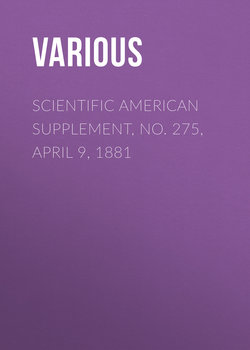Читать книгу Scientific American Supplement, No. 275, April 9, 1881 - Various - Страница 13
HORTICULTURAL NOTES
ОглавлениеThe Western New York Society met at Rochester, January 26.
New Apples, Pears, Grapes, etc.--Wm. C Barry, secretary of the committee on native fruits, read a full report. Among the older varieties of the apple, he strongly recommended Button Beauty, which had proved so excellent in Massachusetts, and which had been equally successful at the Mount Hope Nurseries at Rochester; the fine growth of the tree and its great productiveness being strongly in its favor. The Wagener and Northern Spy are among the finer sorts. The Melon is one of the best among the older sorts; the fruit being quite tender will not bear long shipment, but it possesses great value for home use, and being a poor grower, it had been thrown aside by nurserymen and orchardists. It should be top-grafted on more vigorous sorts. The Jonathan is another fine sort of slender growth, which should be top-grafted.
Among new pears, Hoosic and Frederic Clapp were highly commended for their excellence. Some of the older peaches of fine quality had of late been neglected, and among them Druid Hill and Brevoort.
Among the many new peaches highly recommended for their early ripening, there was great resemblance to each other, and some had proved earlier than Alexander.
Of the new grapes, Lady Washington was the most promising. The Secretary was a failure. The Jefferson was a fine sort, of high promise.
Among the new white grapes, Niagara, Prentiss, and Duchess stood pre-eminent, and were worthy of the attention of cultivators. The Vergennes, from Vermont, a light amber colored sort, was also highly commended. The Elvira, so highly valued in Missouri, does not succeed well here. Several facts were stated in relation to the Delaware grape, showing its reliability and excellence.
Several new varieties of the raspberry were named, but few of them were found equal to the best old sorts. If Brinckle's Orange were taken as a standard for quality, it would show that none had proved its equal in fine quality. The Caroline was like it in color, but inferior in flavor. The New Rochelle was of second quality. Turner was a good berry, but too soft for distant carriage.
Of the many new strawberries named, each seemed to have some special drawback. The Bidwell, however, was a new sort of particular excellence, and Charles Downing thinks it the most promising of the new berries.
Discussion on Grapes.--C. W. Beadle, of Ontario, in allusion to Moore's Early grape, finds it much earlier than the Concord, and equal to it in quality, ripening even before the Hartford. S. D. Willard, of Geneva, thought it inferior to the Concord, and not nearly so good as the Worden. The last named was both earlier and better than the Concord, and sold for seven cents per pound when the Concord brought only four cents. C. A. Green, of Monroe County, said the Lady Washington proved to be a very fine grape, slightly later than Concord. P. L. Perry, of Canandaigua, said that the Vergennes ripens with Hartford, and possesses remarkable keeping qualities, and is of excellent quality and free from pulp. He presented specimens which had been kept in good condition. He added, in relation to the Worden grape, that some years ago it brought 18 cents per pound in New York when the Concord sold three days later for only 8 cents. [In such comparisons, however, it should be borne in mind that new varieties usually receive more attention and better culture, giving them an additional advantage.]
The Niagara grape received special attention from members. A. C. Younglove, of Yates County, thought it superior to any other white grape for its many good qualities. It was a vigorous and healthy grower, and the clusters were full and handsome. W. J. Fowler, of Monroe County, saw the vine in October, with the leaves still hanging well, a great bearer and the grape of fine quality. C. L. Hoag, of Lockport, said he began to pick the Niagara on the 26th of August, but its quality improved by hanging on the vine. J. Harris, of Niagara County, was well acquainted with the Niagara, and indorsed all the commendation which had been uttered in its favor. T. C. Maxwell said there was one fault–we could not get it, as it was not in market. W. C. Barry, of Rochester, spoke highly of the Niagara, and its slight foxiness would be no objection to those who like that peculiarity. C. L. Hoag thought this was the same quality that Col. Wilder described as "a little aromatic." A. C. Younglove found the Niagara to ripen with the Delaware. Inquiry being made relative to the Pockington grape, H. E. Hooker said it ripened as early as the Concord. C. A. Green was surprised that it had not attracted more attention, as he regarded it as a very promising grape. J. Charlton, of Rochester, said that the fruit had been cut for market on the 29th of August, and on the 6th of September it was fully ripe; but he has known it to hang as late as November. J. S. Stone had found that when it hung as late as November it became sweet and very rich in flavor.
